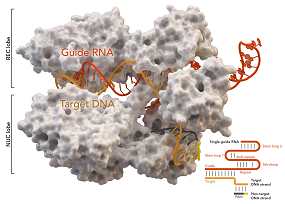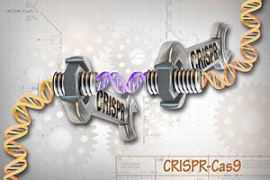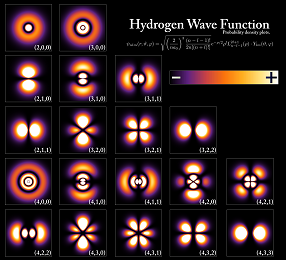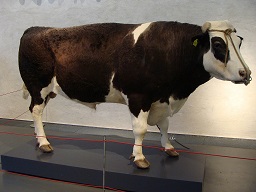When researchers discovered the CRISPR-Cas mechanism, it was looked upon as the perfect instrument for genetic modification (GM). But it appears to have its flaws. Flaws that might be inherent to life and to nature as such.
This is a shortened passage from the book ‘Naturally! Of course. How nature never stops surprising us’ (in Dutch), by Alle Bruggink and Diederik van der Hoeven.

At first, researchers were of the opinion that Cas-9 was the perfect DNA scissors, and CRISPR was the perfect DNA glue. For biotechnologists, a whole new world seemed to open up. They now commanded a miracle of precision, a kind of Swiss army knife. But a mere six years after the discovery, CRISPR-Cas9 proved to make mistakes. Mistakes? At any rate, the process had unintended effects. Cas-9 cut at more locations in the DNA; sometimes way off target. Researchers had overlooked this because they had not investigated those locations. Or maybe it was not Cas-9 that made the cut. With our action, we might have sent an alarm signal to an emergency service of the cell, that subsequently tried to ‘repair’ the damage. Possibly with even more damage as a result. Emergency services of the cell: we know that they exist, but we know preciously little about them. In some cases, researchers report, thousands of ‘letters’ of a DNA strain have vanished.
Nature has a logic of its own
We might have preferred another outcome. In our technology, we often take an engineer’s point of view: as if our material were iron or crude oil, dead matter. But dead matter doesn’t have emergency services. Nature appears to have a logic of its own, a logic that we just start to understand a little bit. An organism that is attacked will try to defend itself. It will do so through traditional mechanisms – mechanisms known to nature for millions or even billions of years, whereas it keeps learning all the time. Pathogens becoming resistant to medicines, another piece of nature’s logic, are well-known to us. For some antibiotics, resistance is being reported as they are on the market just for a couple of months. Our research of nature is just in its infant’s shoes.

We deal with nature more intensely all the time. The greenhouse effect forces us to harvest energy in much the same way as nature does. We produce ever more medicines, food ingredients and construction materials from nature’s resources, treated by genetically modified organisms, our work horses. The fossil era comes to an end, we will evolve to a new understanding with nature. In the past, when constructing a wooden house or ship, we had to take into account that the wood could warp; now we have to be aware that the organisms we change can develop a ‘logic of their own’. A logic that will lead to ‘mistakes’ in the process, from our human point of view.
Nature will always show some unpredictability
People who are used to process iron and crude oil may tend to think: these are start-up problems. As we learn to know more about life’s processes, what their characteristics are and how they function, we will be able to overcome them. Then eventually we will be able to acquire great precision in processing living cells. But the ‘mistakes’ may be part and parcel of the biochemical processes of life itself. Spontaneous genetic modifications appear not to be rare at all. We can only understand many processes in living organisms by taking into account quantum mechanics; and therefore we cannot predict them with 100% certainty. That is a major recent discovery, on which the British authors Jim Al-Khalili en Johnjoe McFadden wrote a fine book: Life on the edge. Until quite recently, we thought that quantum mechanical processes were confined to the realm of physics. But quite recently we discovered that they play an essential role within enzymes, in DNA and in other nanostructures in living cells.

We learn from quantum mechanics that we never know the exact location of the smallest particles of living matter, electrons and protons. This is because they are half particle, i.e. matter, and half wave, i.e. etheric. As a wave, they can move around with almost the speed of light. Quantum mechanics teaches us that the uncertainty increases as we try to locate the electron more precisely. In other words: if we try to locate the electron as a particle, it will increasingly behave as a wave. Biochemical processes in living cells appear to make use of this. That is the explanation of the phenomenon, for instance, that an action on one side of a large protein molecule can prompt an immediate reaction on the other side – with a speed that would be impossible if electrons and protons were mere particles. Until recently, we thought that such processes were impossible in living systems.
‘Erroneous’ outcomes
In the body, cells divide all the time; and in each instance, DNA has to be read and copied. If the smallest components of living matter cannot be located with precision, then that may be the ultimate source of ‘mistakes’ in the process. And we may have to conclude that these are no mistakes at all, but the way in which life develops and changes continuously, the source of evolution. We then better understand that nature sometimes reacts in surprising ways, maybe even showing extreme reactions in some instances. Like for instance the unintended DNA changes at distant locations, in a CRISPR treatment. And like the unexpected appearance of cancers when we first applied gene therapy on humans, back in the nineties.
Therefore, each time we process living matter, the result may be different from what we intended. Until now, almost all genetic treatments intend to prevent unwanted living organisms from multiplying. We would like to protect the cotton plant from being attacked by vermin and therefore produce Bt cotton. But increasingly, genetic researchers intend to promote the build-up of desired living organisms. And then, mistakes are no longer harmless.

Genetic modification of animals and humans
As soon as animals come into play, ethical arguments become valid. All the more so if human beings are involved. Any mistake will then have an ethical component. Cloning animals for instance is much debated, particularly because so many errors occur during this process. Herman the Bull for instance, the first cloned bovine, who lived from 1990 to 2004 in the Netherlands, was the only survivor of 1154 fertilized modified egg cells. Most fertilized egg cells were not viable, or the little calves were deformed, or not genetically changed. The attempts to produce Dolly the Sheep, a transgenic sheep from Scotland (1996-2003), were ‘more successful’: it required 277 attempts to produce one viable sheep. In 2014, Chinese researchers told the world that 70-80% of the attempts to clone pigs were successful. But when 2018 other Chinese researchers proudly announced the production of two cloned macaque monkeys, they had still needed 79 attempts to produce two monkeys. According to provisional news, they are healthy – but that is jus far as we know.
Let’s say we need much more certainty before we could use these techniques at some scale, particularly on humans! Therefore, it doesn’t comfort us that He Jiankui, the man who produced two hiv resistant babies in 2018, did not tell the world anything about his failed attempts. And how will we treat the problem that will surface soon: the i-GONAD method, that will allow us to genetically change egg cells while still in the uterus? How will we be able to establish any unintended defects in them? And how will we be able to prevent greedy entrepreneurs from making use of the gullibility of prospective parents – in full view of the authorities, or behind their backs? How can we prevent them to deposit their failings on the plates of the unfortunate parents?
Even modern biotechnology has its shortcomings
Modern biotechnological methods lend themselves primarily to application on one single cell (like a bacterium) or a limited number of cells. In the realm of animals and humans therefore, the ideal objects of experimentation are the sperm cell, the egg cell and the very young embryo. But as Cecile Janssens, professor at Emory University in Atlanta (USA) tells us, modifications in human DNA will not lead to the desired result, most of the time. For the vast majority of human characteristics is determined by many genes. Many human characteristics may even not be primarily determined by DNA. Consider the effect of good food on the length of a person, for instance. Even muscular force (one would be tempted to judge that this very much determined by heredity) is dependent on DNA for a mere 70%. Growing super athletes by DNA modification is not a smart idea, therefore. There may be opportunities in curing the very few diseases determined by a single gene, like Huntington’s or Duchenne’s diseases.
To this insight we can now add the view that ‘mistakes’ in genetic processes are inevitable. Or, from another point of view: evolution will go on forever, at times with unexpected results. We will not be able to control nature. We should therefore become more modest. Trying less to force nature, trying more to move along with it. Nature shows us the phenomenon of co-evolution: species that are each other’s enemies, can kill each other and are always in the business of perfecting their weapons, but still exist side by side. It will not be easy to concede that our power is limited, but we may have to at some point in time. Cooperation may benefit all, in the end.
Finally, a lesson that apparently we don’t want to accept: nature makes no mistakes; it is our limited insight into nature that troubles us.
Interesting? Then also read:
Psychology of innovation: biotechnology should learn to listen!
Genetic engineering serves sustainability
Antibiotics resistance, do ants have the solution?
